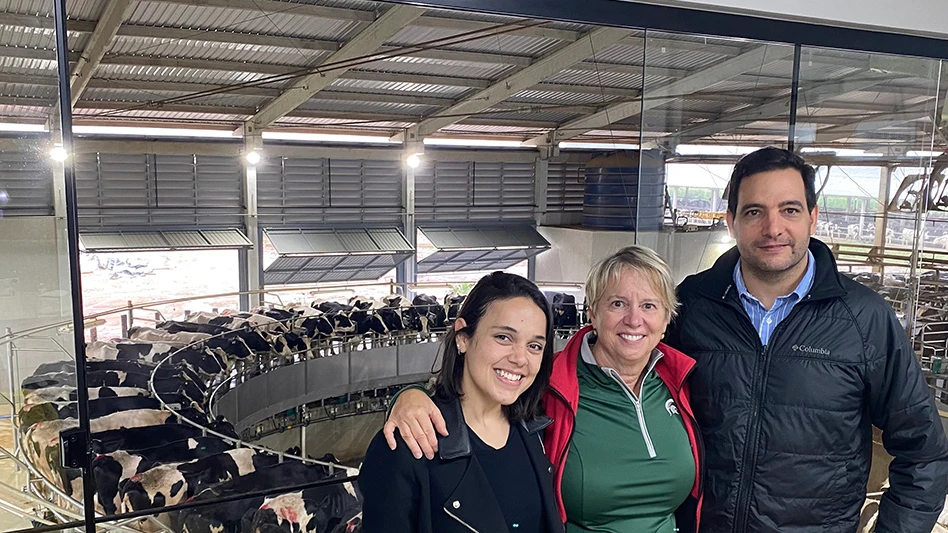
Photos courtesy MSU
EAST LANSING, Mich. — New research from the College of Veterinary Medicine at Michigan State University finds that dairy producers overtreat cows diagnosed with non-severe cases of clinical mastitis, which increases farm costs and loss of milk.
Pamela Ruegg, the David J. Ellis Chair in Antimicrobial Resistance and professor in the Department of Large Animal Clinical Sciences, estimates the direct costs of treatment could be reduced by $65.20 per case if the minimum labeled durations are used, which she said provides the same health outcomes as current practices. The cost of mastitis to the U.S. dairy industry is approximately $110 per cow per year — and that dollar amount increases annually.
In dairy cows, mastitis is the inflammation of mammary glands in the udder, usually caused by a bacterial infection that leads to decreased quantity and quality of milk. Milk produced by cows while they’re being treated with antibiotics must be discarded, as well as the milk produced after treatment during the withholding period — usually three to four days after the last treatment has been given.
Published in the Journal of Dairy Science, Ruegg analyzed non-severe cases of clinical mastitis for approximately 50,000 cows on 37 commercial dairy farms in Wisconsin. She found that milk discarded due to antibiotic treatment represents at least 53% and up to 80% of total direct costs for each day of treatment.

The bottom line: Ruegg found that for routine treatments, following the minimum labelled duration for mastitis treatment drugs is critical to farm cost savings and productivity, as well as maintaining animal and human health.
“Our work indicates that we need to take a hard look at duration of treatment, and unless you can justify improved clinical outcomes, we should treat using the minimum duration listed on product labels, and for shorter durations,” Ruegg said. “With that, there’s both a financial savings for the producer, and there’s a human health benefit because we’re putting less antimicrobials into our ecosystems. There are benefits for society, and guess what? You’ll have the same outcomes.”
The opportunity to save on the cost of treatment and regain revenue from less discarded milk is hard to ignore for producers who are already facing steep fiscal challenges, MSU reports. Dairy producers in the U.S. are battling against federal milk pricing regulations and pandemic aftermath, losing on average more than $6 per hundredweight (milk sales unit) on farms of more than 50 cows.
And mastitis isn’t going anywhere, Ruegg said.
“The proportion of cows with clinical mastitis isn’t going down,” she said. “At best, it’s stable, and at worst, it’s increasing, probably because of environmental pathogens that tend to cause larger inflammatory responses.”
Mastitis is an expensive disease. Ruegg said because cows now produce almost twice as much milk since she started practicing in 1984, the same treatment protocol today costs approximately 40% more.
“We have five products labeled to treat clinical mastitis in the U.S.,” said Ruegg. “The FDA-approved labeled duration of treatment with those drugs ranges from one day to up to eight days. People generally treat for five days because the milk remains visually abnormal on average for five days. Dairy farmers feel like they should treat until it looks like it’s cured. But a lot of our previous work has shown that the abnormal milk appearance is from inflammation, and it’s not predictive of any outcomes like the presence of bacteria or infection recurrence. Again, there’s no benefit.”
Latest from Quality Assurance & Food Safety
- FDA Bans Use of Red No. 3 in Food and Ingested Drugs
- AFDO to Host Course on Implementing Risk-Based Inspections and Auditing for Retail Food Establishments
- FDA Issues Proposed Rule on Front-of-Package Nutrition Labeling
- IAFP 2025 Registration Now Open
- Albertsons Companies Hosts Annual Competition for Emerging, Innovative Food, Beverage and Pet Products
- FDA Releases Long-Term National Strategy to Increase Resiliency of U.S. Infant Formula Market
- Extinguishing the Risk of Foodborne Illness During Wildfires
- FSIS Issues Public Health Alert for Frozen, Raw Ground Beef Products Due to Possible Foreign Matter Contamination





